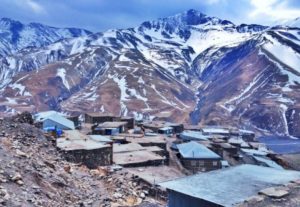
Khinalig is the ancient village in Azerbaijan, and located just north of Quba in the middle of the Greater Caucasus mountains that divide Russia and the South Caucasus. Khinalug is also the highest, most remote and isolated village in Azerbaijan and among the highest in the Caucasus.
Over 5,000 years old, Khinalig has developed its own culture and traditions, and even its own language, which is an isolate within the Northeast Caucasian language family, although many speak Azerbaijani as well. For centuries, this village was cut off from the rest of civilization by the tall mountains and dangerous rocky cliffs. Due to the isolation, the villagers were able to preserve their own unique language, which doesn’t belong to any other language family, as well as their traditions and customs, found nowhere else, states a report by Azerbaijan’s State News Agency Azertac.
There are about 2,000 people living in the village, divided into four families. Each family has its own graveyard and its own patterns for carpets and clothing. The villagers of Khinalig build their houses one on top of the other. In general, they resemble a multi-story house, where the roof of one house is the courtyard for the one built above it. There are 360 stone houses in the village, each of which is about 200-300 years old.
The residents of Khinalig are very religious. There are a lot of holy places not far from the village, such as the graves of saints, caves, and unexplored archaeological sites. Some of them were built as early as the Middle Ages. Dedicated explorers can find the Khydyr Nabi Tomb, Sheikh Shalbuza Mosque, Abu Muslim Mosque (12th century) and the Pirdzhomyard Mosque (1388). The local culture is preserved in the Historical and Ethnographic Museum of Khinalig, where visitors can find items used in traditional life and small exhibits about the history and customs of the local villagers.
The weather in Khinalig changes dramatically during summer and winter, ranging from −20 °C to 18 °C.
On October 7, 2006, the President of Azerbaijan Ilham Aliyev announced plans to modernise the educational buildings, infrastructure, governmental buildings and other resources of Khinalug.
With the construction of a new paved road in 2006, local life changed a lot. Tourists started visiting, and locals got a chance to leave the village. They buy goods in Guba, and trade homespun items, food products, and host and feed tourists who want to get to know this unique village. Khinalig became a little less isolated, though it still retains its unique character. In 2007, Khinalig became a state historical, architectural and ethnographic reserve.
Khinalug was included on the World Monuments Fund’s 2008 Watch List of the 100 Most Endangered Sites due to concern over the building of a road between Khinalug and Guba. The listing is not intended to criticise potential tourist and commercial activity in Khinalug, rather it is intended as a warning that new development should not come at the cost of the site’s essential, historic character.





